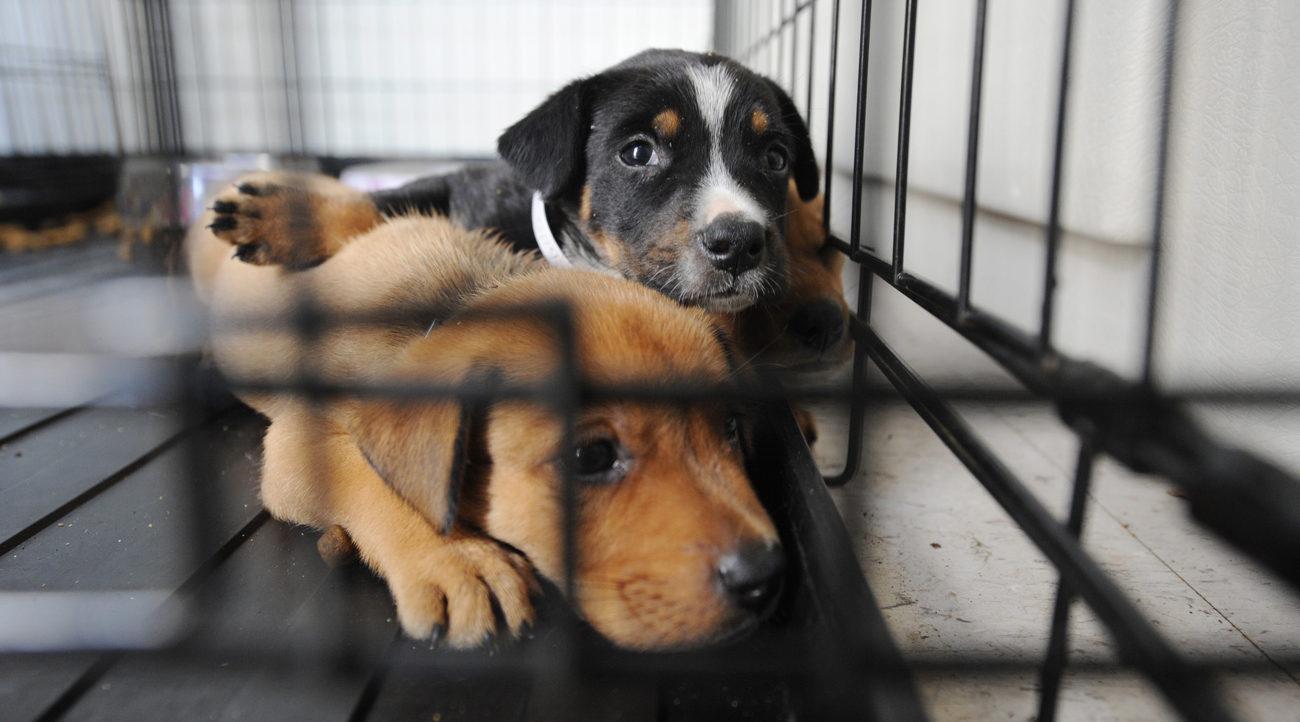Giving a Shelter Dog Shelter
October is Adopt a Dog Month. Not to be confused with Adopt a Child month, which is in November. Talk about a chance to brighten up your life and bring some love into the house! There are lots of ways to obtain a pet – rescue or adopting from a shelter, getting one from a breeder, finding one on the street, adopting one from a private owner and adopting one from a pet store. The truth is, pets can be wonderful no matter where you get one. But saving a life by rescuing one who otherwise doesn’t have a home is a rewarding, very mutually beneficial experience. Please consider going to your local shelter or one in the city, or go through a rescue organization and get yourself a pet. They will typically be spayed or neutered already, completely vaccinated, and ready to go as a perfect companion.
The field of genetics is interesting. When two human beings have a standard baby together, we are sure of several things. This baby will have a head. This baby will have two limbs extending from the shoulders and two from the pelvis. They will have external features indicating their sex. They will have two ears, two elbows, a belly button and a cute little tooshy. Temperment, food preferences, hair and eye color and personality traits are sometimes predictable based on the parents, but generally not. Each child ends up being unique and wonderful, regardless. While some parents want a boy or a girl, or prefer dad’s blond hair or mom’s blue eyes, parents will typically, if they can, love that child no matter what.
Much more is expected of a puppy that is born to a purebred dog. Most likely, a male and female of that breed are brought together with some investment – a distant car ride or an airplane ride. They mate and 2 months later with great anticipation, puppies are born. Of course they are all really cute. However, even more importantly, are they good quality for sale? Are they the right color? Do they have high quality traits that make them valuable and expensive? How much money can “they”, the breeders, get for the puppy? It is all about money and this is just a fact. The puppies are advertised and sometimes up to $2500 is spent, or more, to get a desired individual. For those spending that money, the dog better have the expected traits the purchaser has read about or knows to be characteristic for this breed. It’s like a robot was especially built for the family.
Now let’s take a look at the dog next door who mates with the dog down the street. These puppies are born and of course they are really cute. But they are mutts. They are a mix of heaven-knows-what and they will grow up to look like Buddha knows what. Sometimes, however, mutts can look purebred because of genetics. At the right time and the right place, a person wants one of these puppies and they become a best friend for many years. That is the best case scenario. One hopes that the relationship lasts forever, but sometimes things just don’t work out the way they should. That adoreable puppy grows up and suddenly isn’t so cute anymore. He has an underbite, his tail is too short, he’s a little aggressive towards other dogs. Maybe he even growls at the neighbor. Not so cute anymore and the adopter finds these inadequacies not acceptable. So now what? Hello shelter. Purebreds can also, and frequently do, end up in the shelter. Perhaps the breed wasn’t what they expected.
Whether purebred or not, there are some pretty common reasons why animals end up in shelters. In this economy, people frequently underestimate costs involved with basic veterinary care. Consequently, they are forced to relinquish their dog or cat. In addition, people move and their new place can’t take pets. People can get evicted and just abandon their pets Sometimes there is a death of an owner and family members put these pets in shelters or military people go overseas and can’t keep their pet. Sometimes fleas make people relinquish their pet or a minor medical condition that requires a simple treatment. The bottom line, these animals are normal, lovely animals that end up on a dark and lonely road for various reasons. They just need someone to drive by and pick them up for a second chance.
Most cities have what is called Animal Control. This is a government funded facility that takes in strays and unwanted animals. They vary in terms of quality from city to city. Some have veterinarians. Some don’t. Some readily euthanize. Some have busy “life saving” departments and intense efforts are made to provide live exits for as many animals as possible. Most of these places have dedicated workers who love animals and provide the best care possible. It is a tough job and it is risky. Employees of animal control know how to handle animals better than most. Then there are local shelters or humane societies which do not receive government funding. The funding is a results of adoptions, fund raising and donations. People also put shelters in their will.
There are regional variations as to why animals are in shelters. Down south there are many strays that end up in “kill” shelters where the animals are readily euthanized because there is just not enough space. While a “no kill” shelter sounds so much better, these shelters typically only accomodate “adoptable” pets. This eliminates pitbulls and sick animals. In the average shelter or animal control, there is a significant euthanasia rate because of the quantity of animals there and the limited space and funds. This is a sad reality. Philadelphia does an outstanding job of creating “live exits” for our animals. This requires tons of hard work and outreach to get these animals exposure to the public. Frequently, rescue groups will go to Animal Control and hand pick animals to adopt out.
Some rescue groups like to take sick or injured. Others take only small dogs. There are lots of rescues who bring up dogs from the south to save their lives. And, there are lots of rescue groups who focus on specific breeds or situations. For example, the National Greyhound Adoption Program rescues retired greyhounds that would otherwise be euthanized from the track. Each year, hundreds of these dogs are brought up in trailers and placed in our facility. They are bathed, dewormed, vaccinated, spayed or neutered, microchipped, and all medical conditions are addressed. These are wonderful dogs who serve American greed until they are no longer of use. We give them a second chance in a state of the art facility and you are welcome to visit anytime. If you check our website, there is actually a nice article about saving a life. www.NGAP.org.
Once an animal is dumped at a shelter, there is a whole protocol that is followed to make sure they are adequately vaccinated and spayed or neutered. Often times a microchip is placed so that the animal is tracked back to the shelter if he or she is ever lost or stolen. Any medical attention necessary is given. Those that are very sick, old or may have bad behavior problems may be euthanized. However, most animals are put up for adoption or picked up by rescue groups.
How animals are handled depends on the shelter. There are some shelters that are lousy at live exits and animals are euthanized very quickly. Some shelters don’t even have veterinarians on staff and in fact use local veterinary clinics for the shelter animals’ care.
Getting an animal at a shelter is a gift to both the animal and the adopter. They are usually wonderful, normal, healthy animals that just need a healthy chance. That is not to say that breeder dogs and pet store animals aren’t wonderful. They are. They just won’t be euthanized if not purchased. The chance of euthanasia increases on a daily basis when an animal is in a shelter because the animal is continuously exposed to upper respiratory infections, like a nursery school. If he or she gets very sick and doesn’t respond to treatment, there is a greater chance of euthanasia because of lack of funds to treat.
A nice feature of shelters and rescues is that fostering is frequently offered. This involves a volunteer who takes the animal and brings him or her into their home so that the animal is out of the shelter. This decreases the chances of getting sick from a respiratory infection. This also allows the foster parent to increase the chances of exposure of this animal so someone is more likely to adopt it. In addition, the foster parent may actually end up adopting the animals so it is a win win situation!! We call this a failed foster. We love that the animal gets adopted. But, this is one less foster home.
Adopting from a shelter is one way to help an animal. Another way is to help at the shelter. And another way is to become a foster parent. Rescues often don’t have a home base, but instead rely on fostering to house these animals brought up from the South or rescued from animal control. Look online at local shelters and rescues and see where you can help.
Having a dog in your life is definitely work and an investment to be taken incredibly seriously. However, it is the best investment you make. Start looking into this and come to Dutton Road Veterinary Clinic for your veterinary care. We are non-profit and rescuing dogs is our speciality!
Aime Berman, V.M.D.
Medical Director
Dutton Road Veterinary Clinic





